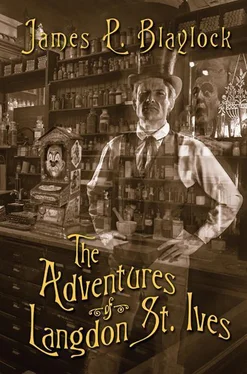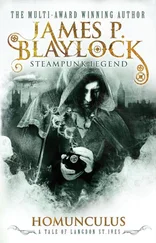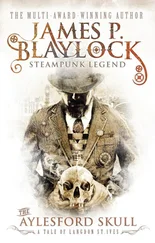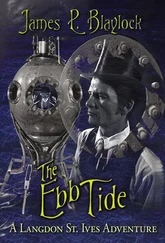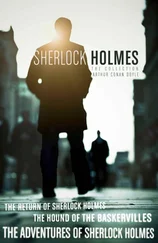“I’m not telling you either of those, am I? If I chose to tell you the truth about the matter, which I clearly don’t choose to do, you wouldn’t believe it anyway. It would confound you. Suffice it to say that the man is willing to sacrifice ambition for the good of humanity.”
St. Ives nodded, giving his chicken a desultory poke with the end of his finger. It might easily have been some sort of pale tide-pool creature shifting in a saline broth on the plate. Ambition…He had his own share of ambition. He had long suspected the nature of the device that Lord Kelvin tinkered with in his barn in Harrogate. Parsons was telling him the truth, or at least part of it. And what the truth meant was that St. Ives, somehow, must possess himself of this fabulous machine.
Except that the idea of doing so was contemptible. There were winds in this world that blew a man into uncharted seas. But while they changed the course of his action, they ought not to change the course of his soul. Take a lesson from Robinson Crusoe, he told himself. He thought about Alice then, and of the brief time they had spent together. Suddenly he determined to hack the weeds out of her vegetable garden, and the thought buoyed him up. Then, just as suddenly, he was depressed beyond words, and he found himself staring at the mess on his plate. Parsons was looking contentedly out the window, picking at his teeth with a fingernail.
First things first, St. Ives said to himself. Reverse the polarity of the earth! “Have you read the works of young Rutherford?” he asked Parsons.
“Pinwinnie Rutherford of Edinburgh?”
“Ernest Rutherford. Of New Zealand. I ran across him in Canada. He’s done some interesting work in the area of light rays, if you can call them that.” St. Ives wiggled loose a thread of chicken, carried the morsel halfway to his mouth, looked at and changed his mind. “There’s some indication that alpha and beta rays from the sun slide away along the earth’s magnetic field, arriving harmlessly at the poles. It seems likely, at a hasty glance, that without the field they’d sail in straightaway — we’d be bathed in radioactivity. The most frightful mutations might occur. It has been my pet theory, in fact, that the dinosaurs were laid low in precisely that same fashion — that their demise was a consequence of the reversal of the poles and the inherent cessation of the magnetic field.”
Parsons shrugged. “All of this is theory, of course. But the comet is eight days away, and that’s not at all theory. It’s not a brontosaurus, my dear fellow, it’s an enormous chunk of iron that threatens to smash us into jelly. From your chair across the able it’s easy enough to fly in the face of the science of mechanics, but I’m afraid, sir, that Lord Kelvin will get along very well without you — he has in the past.”
“There’s a better way,” said St. Ives simply. It was useless to lose his temper over Parsons’s practiced stubbornness.
“Oh?” said the secretary.
“Ignacio Narbondo, I believe, has showed it to us.”
Parsons dropped his spoon onto his lap and launched into a choking fit. St. Ives held up a constraining hand. “I’m very much aware of his threats, I assure you. And they’re not idle threats, either. Do you propose to pay him?”
“I’m constrained from discussing it.”
“He’ll do what he claims. He’s taken the first steps already.”
“I realize, my dear fellow, that you and the doctor are sworn enemies. He ought to have danced his last jig on the gallows a long time ago. If it were in my power to bring him to justice, I would, but I have no earthly idea where he is, quite frankly, and I’ll warn you, with no beating about the bush, that this business of the comet must not become a personal matter with you. I believe you take my meaning. Lord Kelvin sets us all an example.”
St. Ives counted to ten very slowly. Somewhere between seven and eight, he discovered that Parsons was very nearly right. What he said was beside the point, though. “Let me repeat,” St. Ives said evenly, “that I believe there’s a better way.”
“And what does a lunatic like Narbondo have to do with this ‘better way’?”
“He intends, if I read him aright, to effect the stoppage of certain very active volcanoes in arctic Scandinavia via the introduction of petrifactive catalysts into open fissures and dykes. The subsequent detonation of an explosive charge would lead to the eruption of a chain of volcanic mountains that rise above the jungles of Amazonian Peru. The entrapped energy expended by such an upheaval would, he hopes, cast us like a Chinese rocket into the course of the comet.”
“Given the structure of the interior of the earth,” said Parsons, grinning into his mineral water, “it seems a dubious undertaking at best. Perhaps…”
“Are you familiar with hollow-earth theory?”
Parsons blinked at St. Ives. The corners of his mouth twitched.
“Specifically with that of McClung-Jones of the Quebec Geological Mechanics Institute? The ‘thin-crust phenomenon’?”
Parsons shook his head tiredly.
“It’s possible,” said St. Ives, “that Narbondo’s detonation will effect a series of eruptions in volcanoes residing in the hollow core of the earth. The stupendous inner-earth pressures would themselves trigger an eruption at Jones’s thin-crust point.”
“Thin-crust point?” asked Parsons in a plonking tone.
“The very Peruvian mountains toward which our man Narbondo has cast the glad eye!”
“That’s an interesting notion,” muttered Parsons, coughing into his napkin. “Turn the earth into a Chinese rocket.” He stared out the window, blinking his eyes ponderously, as if satisfied that St. Ives had concluded his speech.
“What I propose,” said St. Ives, pressing on, “is to thwart Narbondo, and then effect the same thing, only in reverse — to propel the earth temporarily out of her orbit in a long arc that would put the comet beyond her grasp. If the calculations were fined down sufficiently — and I can assure you that they have been — we’d simply slide back into orbit some few thousand miles farther along our ellipse, a pittance in the eyes of the incalculable distances of our journeying through the void.”
St. Ives sat back and fished in his coat for a cigar. Here was the Royal Academy, unutterably fearful of the machinations of Ignacio Narbondo — certain, that is, that the doctor was not merely talking through his hat. If they could trust to Narbondo to destroy the earth through volcanic manipulation, then they could quite clearly trust St. Ives to save it by the same means. What was good for the goose, after all. St. Ives took a breath and continued. “There’s been some study of the disastrous effects of in-step marching on bridges and platforms — military study mostly. My own theory, which abets Narbondo’s, would make use of such study, of the resonant energy expended by a troop of synchronized marchers…”
Parsons grimaced and shook his head slowly. He wasn’t prepared to admit anything about the doings of the nefarious doctor. And St. Ives’s theories, although fascinating, were of little use to them here. What St. Ives wanted, perhaps, was to speak to the minister of parades…
Then there was this man Jones. Hadn’t McClung-Jones been involved in certain ghastly lizard experiments in the forests of New Hampshire? “Very ugly incident, that one,” Parsons muttered sadly. “One of your hollow-earth men, wasn’t he? Had a lot of Mesozoic reptiles dummied up at a waxworks in Boston, as I recall, and insisted he’d found them sporting in some bottomless cavern or another.” Parsons squinted shrewdly at St. Ives. It was real science that they would order up here. Humanity cried out for it, didn’t they? Wasn’t Lord Kelvin at that very moment riveting together the carcass of the device that Parsons had described? Hadn’t St. Ives been listening? Parsons shrugged. Discussions with St. Ives were always — how should one put it? — revealing. But St. Ives had gotten in out of his depth this time, and Parsons’s advice was to strike out at once for shore — a hearty breaststroke so as not to tire himself unduly. He patted St. Ives on the sleeve, waving the wine decanter at him.
Читать дальше
